Chris Henry Had CTE Before Death, And Why That Matters So Much
 by Adam Jacobi on Jun 29, 2010 8:00 AM CDT in Football
by Adam Jacobi on Jun 29, 2010 8:00 AM CDT in Football
There are no mentions of Iowa sports in this post, but rest assured it will affect all of football very soon.--AJ
As the football world has come to better understand the causes and effects of brain damage in its sport, three general assumptions about Chronic Traumatic Encephalopathy (CTE) started to take hold:
- It is a result of concussions, particularly multiple concussions
- It happens to people with long, contact-filled careers
- Its onset happens later in life
Basically, the general consensus was that Mike Webster was the poster child for CTE.
And then Chris Henry died, and now there's evidence that blows up all three of those assumptions. And that is just about the worst news possible for the sport of football.

In fact, not only does Henry satisfy none of those three conditions, he doesn't even come close. Down the line:
It is a result of concussions, especially multiple concussions: If Henry ever suffered a concussion, it was news to his teams; Henry never missed a game to head injury during his career at West Virginia or Cincinnati.
It happens to people with long, contact-filled careers Chris Henry spent four years at West Virginia, then five in the NFL. But even those numbers are both somewhat inflated; Henry redshirted one of those four years at WVU, declaring for the draft after his junior year. Once in the NFL, Henry was suspended for half a year due to arrests--some of which included erratic, violent behavior. So of those nine seasons after high school, Henry was actually playing for just 7 and a half.
Further, Henry played wide receiver, one of the least contact-intensive positions in sport. Yes, Colin Sandeman can surely attest to how violent the worst hits can be for wideouts. But the repetitious, incessant helmet contact that we've been led to believe (and not unfairly) causes CTE and that linemen, linebackers, and safeties face just isn't there.
Its onset happens later in life Henry died at 26. And not only did he exhibit classic signs of CTE, his brain was already in advanced stages of decay:
Finding CTE in a current pro football player wouldn't surprise Robert Cantu, whose Boston University research group has received funding from the NFL.
"It also wouldn't surprise me that somebody as young as 26 would have it, either," Dr. Cantu said of Mr. Henry. "What would be a big surprise is if the amount of Tau protein. ... would be as excessive as it is in people who had much more lengthy careers and died at a much later age."
"It didn't look like the brain of a 26-year-old," said Dr. Omalu, a former Allegheny County pathologist who first found CTE in an autopsy of Mr. Long in September 2005.
A picture of the tissue study of Henry's frontal cortex, compared to that of a normal brain, is here. As one researcher put it, "you should never see" the red stainings evident in Henry's brain. One would expect them in an Alzheimer's patient.
The absolute worst thing that could happen to the NFL is if multiple players routinely died as a direct result of their play--that the sport had become too brutal for humanity. And not even in a sense of shortened lifespans by 10-20 years, but Jack Trice situations happening left and right. The sport would surely collapse quickly, because human life trumps all.
The next step down from life itself is quality of life, and by that we don't mean how nice your house is or how often you smile. It's how close to "normal" your body and mind are. The lasting physical tolls of football on that quality of life are as well-known as they are devastating. Gnarled fingers and fused joints abound. Earl Campbell can barely walk. The life expectancy of an NFL veteran is currently under 60. Again, well-known, and more or less accepted by everyone involved. Would you accelerate the degenerative effects of aging for a few years of glory and fortune in the league? Many men would.
Mental degeneration, however, is a different beast altogether. When the brain goes, everything goes. The stories of Webster, Terry Long, and Justin Strzelzcyk were all characterized by CTE, depression, substance abuse, violent and erratic behavior, and early, awful deaths. And those were just three guys from one franchise.
It's hard to tell right now what lasting effect a substantial football career has on today's NFL and collegiate players, mainly because CTE can only be conclusively identified during an autopsy. The former athletes who are dying today are primarily in their 60s, 70s, and 80s; they mostly played in an era that didn't involve such violent and repetitive blows to the head. This is not to say that football was ever not a nasty sport, but the players are larger and faster now than they used to be a generation or more ago. Yes, that goes the same for both hitters and hittees (new word alert), but the one thing that hasn't gotten any more suited to contact on either side is the brain.
The NFL has been getting more proactive about concussions recently, but this news puts basically every player in the league--punters and kickers can probably sleep well at night--at substantial risk for serious mental health problems down the road, regardless of whether they've ever actually suffered a concussion. That's not to definitively say that every player's brain is self-destructing, but there's really no way to tell if any of them are suffering from those disastrous effects until the symptoms begin. And by then, frankly it's too late.
The worst case scenario is eradication of the sport as we know it. That likely won't happen, although rules of contact may change substantially. To put it coldly, it depends on whether it's worth it for everyone involved. Money talks--especially when billions are on the table. What's more likely is that the NFL will be more explicit to its entering players about the significant dangers to quality of life if one pursues a life on the gridiron. How much farther they go than that will have to depend on the results of ongoing research. From what we know right now, it's not terribly inspiring.
There's an old phrase about Bernese Mountain Dogs:
"3 years a young dog, 3 years a good dog, 3 years an old dog; the rest is a gift from God." This news about Chris Henry might mean career football players are something close to the same:
"20 years a young man, 20 years an athletic man, 20 years an old man; the rest is a gift from God." As an avowed and diehard football fan, I hope so much that, in the face of the evidence unfolding in fron



 Ralph Cornwell
is a Ph.D. candidate in health promotion/human performance at
Virginia Polytechnic Institute and State University. Prior to
pursuing his Doctoral Degree he was a collegiate strength coach.
Ralph Cornwell
is a Ph.D. candidate in health promotion/human performance at
Virginia Polytechnic Institute and State University. Prior to
pursuing his Doctoral Degree he was a collegiate strength coach.









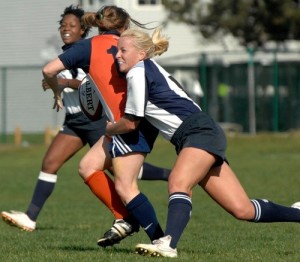



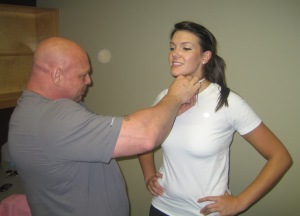

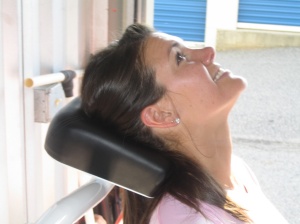
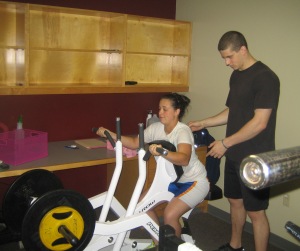
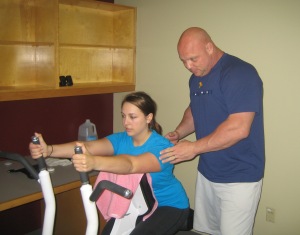



 Charts are charts, they set a course. They give direction. Understand that they are not based on the scientific method and each athlete will be effected differently with the recommended weights and repetitions.
Charts are charts, they set a course. They give direction. Understand that they are not based on the scientific method and each athlete will be effected differently with the recommended weights and repetitions.
 The Pashby Sports Safety Award is an award presented in Canada to recognize and honor people who make sports and recreational activities safer from catastrophic injuries, which typically involve the eyes, spine or brain. Dr. Karen Johnston MD, PHD was given the Safety Award for her outstanding work to prevent injuries, most specifically concussions.
The Pashby Sports Safety Award is an award presented in Canada to recognize and honor people who make sports and recreational activities safer from catastrophic injuries, which typically involve the eyes, spine or brain. Dr. Karen Johnston MD, PHD was given the Safety Award for her outstanding work to prevent injuries, most specifically concussions. Ralph Cornwell is taking this one step further, building bigger stronger cylinders by developing the musculature around the head, neck and thoracic spine. The developed muscles dissipate more force and ‘clenching’ on the mouthguard with a stronger head, neck and jaw augments the value of dissipation by stabilizing movement. This further reduces the subconcussive forces involved in causing a concussion.
Ralph Cornwell is taking this one step further, building bigger stronger cylinders by developing the musculature around the head, neck and thoracic spine. The developed muscles dissipate more force and ‘clenching’ on the mouthguard with a stronger head, neck and jaw augments the value of dissipation by stabilizing movement. This further reduces the subconcussive forces involved in causing a concussion.















 One of the many advantages of neck training is once the head and neck muscles are strong the ability to slow down the acceleration of the head by bracing during contact is enhanced dramatically. As your strength rises so does the built in cellular mechanism of force protection against sudden loads.
One of the many advantages of neck training is once the head and neck muscles are strong the ability to slow down the acceleration of the head by bracing during contact is enhanced dramatically. As your strength rises so does the built in cellular mechanism of force protection against sudden loads.

 by
by 